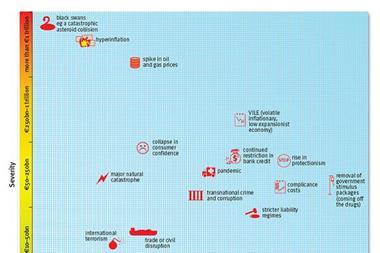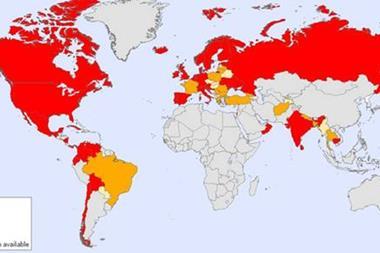Over the last decade pandemics have been the cause of most concern, but other kinds of health risk are increasing
The opening decade of the second milennium has seen plenty of health scares. Some of them have been potentially serious; others have hit the headlines for a week or two, only to die away. For risk managers attempting to stay alert to threats to their organisations, it can be a hard task to decide which to take seriously. The media love a good health scare story and will happily dramatise the threat. Governments, in their turn react defensively and issue precautionary warnings and advice.
Over the last decade, it is the threat of a global pandemic that has been causing the most concern. For a time it seemed possible that the HIV virus which has caused such havoc in some African countries through AIDS-related diseases might spread to other continents with similar devastating effect. Then came SARS – spreading southwards from China, which again brought warnings that we might all be at risk. Fears of ‘avian flu’ were stoked up in 2007, leading to the slaughter of 160,000 turkeys on Norfolk farms. And in the final year of the decade, the H1N1 ‘swine flu’ virus has appeared to be such a potential threat that governments have lavished resources on developing and producing vaccines to protect their populations, while many organisations, large and small, have worked on contingency plans for survival in a context where much of their workforce was sick or absent caring for ill relatives.
When the World Health Organisation declared a swine flu pandemic in June 2009, the UK alone braced itself for 65,000 deaths over the winter. In fact, global mortality from the H1N1 virus stands at just 14,000, leading Dr Wolfgang Wodard, president of the Health committee of the Council of Europe to label the H1N1 scare ‘one of the greatest medical scandals of the century,’ and to call for an investigation into the links between the WHO and the pharmaceutical industry.
The inevitable upshot of a sequence of health crisis alerts which fail to materialise into anything significant is to engender scepticism. It will be a far harder task for risk managers to get their organisations to take such alerts seriously in future, especially if they involve costs which are unlikely to be recovered. This is not helpful, to put it mildly – for the risks remain.
Even if the world continues to escape the kind of pandemic that experts fear will be the inevitable result of our habit of travelling all over the globe so frequently and quickly, we are likely to see other kinds of health risk increasing in importance over the coming decade. High on the list is the fact that we are running out of antibiotics – not literally, but in the sense that bacteria are evolving resistance to many of the best and most commonly used drugs faster than replacements can be engineered. It is this disturbing trend which has lead to increasing mortality from MRSA (Methicillin-resistant Staphylococcus aureus) A 2007 report from the USA estimated that the number of MRSA infections in hospitals had doubled nationwide, from approximately 127,000 in 1999 to 278,000 in 2005.
Of equal concern may be an increasing incidence of drug-resistant strains of the tuberculosis bacterium. Between 2000 to 2004, 20% of TB cases were classed as being resistant to standard treatments and 2% resistant even to second-line drugs. Currently, the risk is greatest in developing countries, for treatment of tuberculosis is lengthy and can be expensive.
If, over the coming decade, we start losing the battle against fast-evolving bacteria more seriously than is the case at present, we may yet see the re-emergence in Europe of some of the infectious or contagious diseases we thought we had under control.
Many of the diseases with the potential to cause a pandemic – such as avian flu or the ebola virus have their reservoirs among animal populations. In 2008, Dr Bernard Vallat, director general of The World Organisation for Animal Health emphasised the convergence of new factors increasing human and animal health risks on a worldwide scale: ‘Approximately 60% of existing human pathogens and over 75% of those that have appeared during the past two decades can be traced back to animals’ he wrote. ‘Many of them have a proven link with wildlife. Furthermore, new factors such as increasingly mobile human populations, climate change, the movement of animals and animal products via international trade, deforestation, urbanisation, and new social habits such as the increasingly common adoption of exotic pets, all favour the unprecedented multiplication of contacts between wildlife, domestic animals and humans.’ Dr Vallat’s organisation has called for improved governance of animal health regulations worldwide to combat this risk. Partially as a result of the perception of this risk, we are likely to find food safety continuing to be a matter of great concern within the developed world.
Finally, there are the risks to health arising from practices or products which have hitherto been considered harmless. We have seen both tobacco and asbestos identified as carcinogens – the next decade will probably uncover more. As an example of an emerging health risk which may yet come to be a matter of concern for organisations, an increasing number of scientific studies are confirming the hypothesis – first advanced in 1987 – that working at night for an unbroken period of years may be linked to cancer – especially breast cancer. Indeed, last year, the Danish National Board of Industrial Injuries paid out compensation to thirty-seven women who had developed cancer after years of working the night shift. Risk managers in organisations where night work is necessary should already be sitting up and taking note.


















